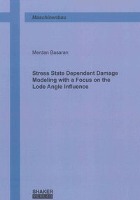Stress State Dependent Damage Modeling with a Focus on the Lode Angle Influence
BücherAngebote / Angebote:
Numerical fracture prediction of metals is of great interest in automotive industry, since it is an effective way to improve crashworthiness of car body parts. In the present thesis, the effect of stress state on damage modeling with the focus on the Lode angle parameter (or third deviatoric stress invariant) is discussed and validated by experimental and numerical studies. The numerical implementation is integrated to the damage model GISSMO (Generalized Incremental Stress State dependant damage MOdel) as an extension, which was proposed by Neukamm et al[1-4]. The model is extended for 3D usage by utilization of Lode angle parameter. The stress state is defined with two stress state parameters, stress triaxiality and Lode angle parameter uniquely. The material ductility (or fracture strain) is considered as a function of the stress triaxiality and Lode angle parameter.
The stress triaxiality and Lode angle parameter space is covered with a series of tests for the dual-phase steel DP600. Tests of axisymmetric notched round specimens, grooved flat specimens and Nakazima were conducted to study the material behavior for Lode angel parameter equal to 1, 0 and -1, respectively. Additionally, for the intermediate stress states, tests of butterfly specimens and flat specimens were carried out.
The representative fracture strain of each test is obtained by combining experimental and numerical results, and parallel corresponding stress state parameters are determined numerically by using proposed weighting functions, which depend on the nonlinear damage accumulation formulation in the GISSMO damage model.
The stress state dependent fracture strain formulation is implemented into the commercial finite element code LS-DYNA. A nine-parameter stress state dependent analytical fracture locus is proposed. In addition, a mathematical fracture strain function based on biharmonic spline method is introduced.
The investigations on the material DP600 show the influence of Lode angle parameter on the fracture strain. With the introduced calibration approach a good correlation is obtained between experimental and numerical force-displacement curves.
Folgt in ca. 2-3 Arbeitstagen
